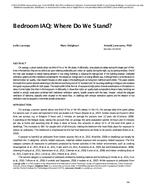Description
On average, a person spends about one third of his or her life asleep. Additionally, since people are asleep during the largest part of their time in the bedroom, they are not able to act upon reaching undesirably poor indoor air quality during the night, e.g. by opening windows. One of the most used strategies to reduce heating demand in low energy buildings is reducing the leakage level of the building envelope. Dedicated ventilation systems are then installed to compensate for the reduced air change rate in an energy efficient way. Although there is some literature on bedroom indoor air quality, most research focusses on other spaces in the dwelling such as living room, bathroom and kitchen. This paper presents the results from carbon dioxide monitoring in the bedroom and living room of 47 standard and 34 low energy dwellings in Belgium and compares the typical exposure profiles for both spaces. The results confirm that the risk of exposure to high carbon dioxide concentrations in the bedroom is about 6 times higher than that in the living room. Additionally, it shows that indoor air quality levels comparable to those in leaky buildings are reached in airtight construction combined with mechanical ventilation systems. Specific concerns with the latter, however, include the adequate ventilation of bedrooms, especially when situated on the second floor, in dwellings with exhaust ventilation systems and the selection of low ventilation rates by occupants in extremely airtight construction.
Citation: IAQ Conference: IAQ 2013: Environmental Health in Low Energy Buildings
Product Details
- Published:
- 2013
- Number of Pages:
- 9
- File Size:
- 1 file , 620 KB
- Product Code(s):
- D-2013IAQConf-81




